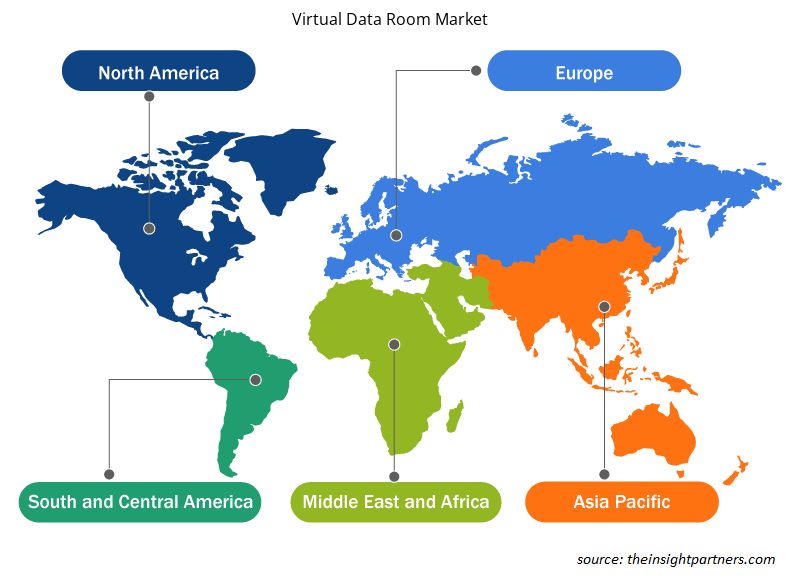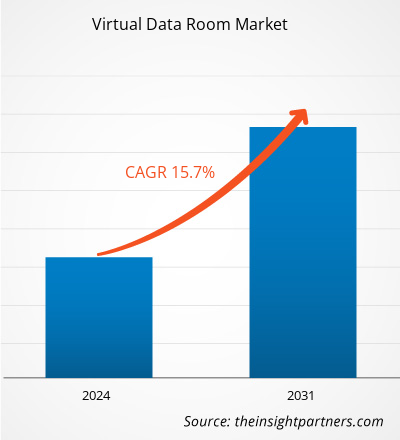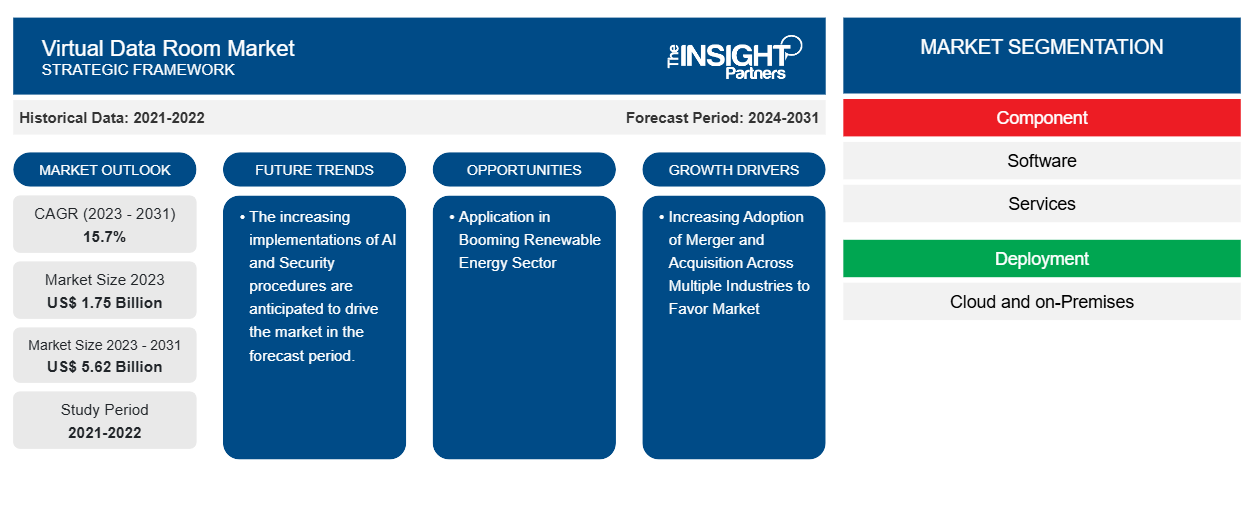Der Markt für virtuelle Datenräume soll von 1,75 Milliarden US-Dollar im Jahr 2023 auf 5,62 Milliarden US-Dollar im Jahr 2031 anwachsen. Für den Zeitraum 2023–2031 wird ein durchschnittliches jährliches Wachstum von 15,7 % erwartet. Die zunehmende Verbreitung von Fusionen und Übernahmen in zahlreichen Branchen und die Entwicklung fortschrittlicher VDR-Technologie für Due-Diligence-Prüfungen dürften weiterhin wichtige Trends und Treiber des Marktes bleiben.
Marktanalyse für virtuelle Datenräume
Der Markt für virtuelle Datenräume verzeichnet weltweit ein erhebliches Wachstum. Dieses Wachstum ist auf Faktoren wie die zunehmende Akzeptanz von Fusionen und Übernahmen in zahlreichen Branchen und die Entwicklung fortschrittlicher VDR-Technologie für Due-Diligence-Prüfungen zurückzuführen. Darüber hinaus wird erwartet, dass die Anwendung im florierenden Sektor der erneuerbaren Energien und die Implementierung von KI und Sicherheitsverfahren mehrere Chancen auf dem Markt für virtuelle Datenräume bieten.
Marktübersicht für virtuelle Datenräume
Ein virtueller Datenraum (VDR), auch Deal Room genannt, ist ein sicheres Online-Repository für die Verteilung und Speicherung von Dokumenten. Er wird typischerweise während des Due-Diligence-Prozesses und bei der Einleitung einer Fusion oder Übernahme genutzt, um Unternehmensdokumente zu prüfen, freizugeben und offenzulegen.
Passen Sie diesen Bericht Ihren Anforderungen an
Sie erhalten kostenlose Anpassungen an jedem Bericht, einschließlich Teilen dieses Berichts oder einer Analyse auf Länderebene, eines Excel-Datenpakets sowie tolle Angebote und Rabatte für Start-ups und Universitäten.
-
Holen Sie sich die wichtigsten Markttrends aus diesem Bericht.Dieses KOSTENLOSE Beispiel umfasst eine Datenanalyse von Markttrends bis hin zu Schätzungen und Prognosen.
Markttreiber und Chancen für virtuelle Datenräume
Zunehmende Nutzung von Fusionen und Übernahmen in zahlreichen Branchen zur Förderung des Marktes.
Die zunehmende Verbreitung von Fusionen und Übernahmen in verschiedenen Branchen treibt tatsächlich den Markt für virtuelle Datenräume an. VDRs werden im Allgemeinen von Unternehmen verwendet, wenn sie fusionieren, an einem Projekt arbeiten oder ein anderes Joint Venture durchführen, das Zugriff auf gemeinsam genutzte Daten benötigt. Darüber hinaus sind verschiedene Organisationen an Aktivitäten wie Fusionen und Übernahmen beteiligt. So erwarb beispielsweise im Juni 2024 ein Unternehmen namens Waste Management Stericycle mit einem Transaktionsvolumen von 7,2 Milliarden US-Dollar. Ebenso erwarb im Juni 2024 ein Unternehmen namens Becton Dickinson Edwards mit einem Transaktionsvolumen von 4,2 Milliarden US-Dollar. Unter Berücksichtigung der oben genannten Parameter treibt also die zunehmende Verbreitung von Fusionen und Übernahmen in verschiedenen Branchen tatsächlich den Markt für virtuelle Datenräume an.
Anwendung im boomenden Sektor der erneuerbaren Energien.
Die Anwendung im boomenden Sektor der erneuerbaren Energien wird in den kommenden Jahren voraussichtlich mehrere Chancen für den Markt für virtuelle Datenräume bieten. Der Sektor der erneuerbaren Energien erlebt ein beträchtliches Wachstum, das durch innovative Fortschritte und den weltweiten Wandel hin zu nachhaltigen Energiequellen gefördert wird. VDR ist ein wichtiges Tool, das diesen Fortschritt unterstützt, eine sichere Online-Plattform zum Speichern, Verwalten und Teilen vertraulicher Dokumente. VDR bietet mehrere Vorteile, wie z. B. effiziente Projektentwicklung, Schutz geistigen Eigentums, Einhaltung gesetzlicher Vorschriften, Rationalisierung von M&A-Aktivitäten, Förderung von Finanzierung und Mittelbeschaffung, Optimierung des Vermögensmanagements und mehr. Unter Berücksichtigung der oben genannten Faktoren wird erwartet, dass der Markt mehrere Chancen für virtuelle Datenräume bietet.
Marktbericht zum virtuellen Datenraum – Segmentierungsanalyse
Wichtige Segmente, die zur Ableitung der Marktanalyse für virtuelle Datenräume beigetragen haben, sind Komponente, Bereitstellung, Organisationsgröße, Geschäftsfunktion und Endbenutzer.
- Basierend auf den Komponenten ist der Markt für virtuelle Datenräume in Software und Dienste unterteilt. Es wird erwartet, dass das Softwaresegment im Prognosezeitraum einen erheblichen Marktanteil halten wird.
- Basierend auf der Bereitstellung wird der Markt für virtuelle Datenräume in On-Premises und Cloud unterteilt. Es wird erwartet, dass das On-Premises-Segment im Prognosezeitraum einen erheblichen Marktanteil halten wird.
- Nach Unternehmensgröße ist der Markt in KMU und Großunternehmen segmentiert. Es wird erwartet, dass die KMU-Segmente im Prognosezeitraum einen erheblichen Marktanteil halten werden.
- Basierend auf der Geschäftsfunktion ist der Markt für virtuelle Datenräume in Fusionen und Übernahmen, Finanzen, Marketing und Vertrieb, Compliance und Recht, Personalmanagement und andere unterteilt. Das Fusions- und Übernahmesegment dürfte im Prognosezeitraum einen erheblichen Marktanteil halten.
- Nach Endverbraucher ist der Markt segmentiert in BFSI, IT und Telekommunikation, Gesundheitswesen, Energie und Strom, Einzelhandel und andere. Die Segmente Energie und Strom werden im Prognosezeitraum voraussichtlich einen erheblichen Marktanteil halten.
Marktanteilsanalyse für virtuelle Datenräume nach geografischer Lage
Der geografische Umfang des Marktberichts für virtuelle Datenräume ist hauptsächlich in fünf Regionen unterteilt: Nordamerika, Asien-Pazifik, Europa, Naher Osten und Afrika sowie Süd- und Mittelamerika.
Nordamerika dominiert den Markt für virtuelle Datenräume. Der nordamerikanische Markt für virtuelle Daten ist in die USA, Kanada und Mexiko unterteilt. Der Markt erlebt ein signifikantes Wachstum, das durch Faktoren wie die zunehmende Akzeptanz von Fusionen und Übernahmen in mehreren Branchen und die Entwicklung fortschrittlicher VDR-Technologie für Due Diligence getrieben wird. Darüber hinaus zwingt eine starke Betonung von Forschung und Entwicklung in den entwickelten Volkswirtschaften der USA und Kanadas die nordamerikanischen Akteure dazu, technologisch fortschrittliche Lösungen auf den Markt zu bringen. Darüber hinaus gibt es in den USA eine große Anzahl von Akteuren auf dem Markt für virtuelle Datenräume, die sich zunehmend auf die Entwicklung innovativer Lösungen konzentrieren. All diese Faktoren tragen zum Wachstum des Marktes für virtuelle Datenräume in der Region bei.
Regionale Einblicke in den Markt für virtuelle Datenräume
Die regionalen Trends und Faktoren, die den Markt für virtuelle Datenräume im Prognosezeitraum beeinflussen, wurden von den Analysten von Insight Partners ausführlich erläutert. In diesem Abschnitt werden auch Marktsegmente und Geografien für virtuelle Datenräume in Nordamerika, Europa, im asiatisch-pazifischen Raum, im Nahen Osten und Afrika sowie in Süd- und Mittelamerika erörtert.

- Holen Sie sich regionale Daten zum Markt für virtuelle Datenräume
Umfang des Marktberichts zum virtuellen Datenraum
| Berichtsattribut | Details |
|---|---|
| Marktgröße im Jahr 2023 | 1,75 Milliarden US-Dollar |
| Marktgröße bis 2031 | 5,62 Milliarden US-Dollar |
| Globale CAGR (2023 - 2031) | 15,7 % |
| Historische Daten | 2021-2022 |
| Prognosezeitraum | 2024–2031 |
| Abgedeckte Segmente |
Nach Komponente
|
| Abgedeckte Regionen und Länder |
Nordamerika
|
| Marktführer und wichtige Unternehmensprofile |
|
Dichte der Marktteilnehmer für virtuelle Datenräume: Die Auswirkungen auf die Geschäftsdynamik verstehen
Der Markt für virtuelle Datenräume wächst rasant, angetrieben durch die steigende Nachfrage der Endnutzer aufgrund von Faktoren wie sich entwickelnden Verbraucherpräferenzen, technologischen Fortschritten und einem größeren Bewusstsein für die Vorteile des Produkts. Mit steigender Nachfrage erweitern Unternehmen ihr Angebot, entwickeln Innovationen, um die Bedürfnisse der Verbraucher zu erfüllen, und nutzen neue Trends, was das Marktwachstum weiter ankurbelt.
Die Marktteilnehmerdichte bezieht sich auf die Verteilung der Firmen oder Unternehmen, die in einem bestimmten Markt oder einer bestimmten Branche tätig sind. Sie gibt an, wie viele Wettbewerber (Marktteilnehmer) in einem bestimmten Marktraum im Verhältnis zu seiner Größe oder seinem gesamten Marktwert präsent sind.
Die wichtigsten auf dem Markt für virtuelle Datenräume tätigen Unternehmen sind:
- Ansarada Group Limited
- BMC-Gruppe, Inc.
- Brainloop AG
- CapLinked
- EthosData
- iDeals Solutions Gruppe
Haftungsausschluss : Die oben aufgeführten Unternehmen sind nicht in einer bestimmten Reihenfolge aufgeführt.

- Überblick über die wichtigsten Akteure auf dem Markt für virtuelle Datenräume
Marktnachrichten und aktuelle Entwicklungen für virtuelle Datenräume
Der Markt für virtuelle Datenräume wird durch die Erhebung qualitativer und quantitativer Daten nach Primär- und Sekundärforschung bewertet, die wichtige Unternehmenspublikationen, Verbandsdaten und Datenbanken umfasst. Nachfolgend sind einige der Entwicklungen auf dem Markt für virtuelle Datenräume aufgeführt:
- Der dateibasierte Partner Egnyte hat einen sicheren virtuellen Datenraum (VDR) für den Austausch vertraulicher Dokumente mit Dritten eingerichtet, mit der Idee, die Notwendigkeit von MOVEit-ähnlichen Dateiübertragungsdiensten zu beseitigen. (Quelle: Egnyte, Unternehmenswebsite, Oktober 2023)
- SentinelOne erweitert sein Angebot in Indien. Das Unternehmen kündigte die Eröffnung eines virtuellen Rechenzentrums in Mumbai an, das es der wachsenden Zahl indischer Unternehmen, die auf SentinelOne vertrauen, ermöglichen wird, ihr Geschäft auf einfache und konforme Weise vor Cyberangriffen zu schützen. (Quelle: SentinelOne Company Website, Juli 2023)
Marktbericht zu virtuellen Datenräumen – Abdeckung und Ergebnisse
Der Bericht „Marktgröße und Prognose für virtuelle Datenräume (2021–2031)“ bietet eine detaillierte Analyse des Marktes, die die folgenden Bereiche abdeckt:
- Marktgröße und Prognose für virtuelle Datenräume auf globaler, regionaler und Länderebene für alle wichtigen Marktsegmente, die im Rahmen des Berichts abgedeckt sind
- Markttrends für virtuelle Datenräume sowie Marktdynamiken wie Treiber, Einschränkungen und wichtige Chancen
- Detaillierte PEST/Porters Five Forces- und SWOT-Analyse
- Marktanalyse für virtuelle Datenräume mit Blick auf wichtige Markttrends, globale und regionale Rahmenbedingungen, wichtige Akteure, Vorschriften und aktuelle Marktentwicklungen
- Branchenlandschaft und Wettbewerbsanalyse, einschließlich Marktkonzentration, Heatmap-Analyse, prominenten Akteuren und aktuellen Entwicklungen für den Markt für virtuelle Datenräume
- Detaillierte Firmenprofile
- Historische Analyse (2 Jahre), Basisjahr, Prognose (7 Jahre) mit CAGR
- PEST- und SWOT-Analyse
- Marktgröße Wert/Volumen – Global, Regional, Land
- Branchen- und Wettbewerbslandschaft
- Excel-Datensatz
Aktuelle Berichte
Verwandte Berichte
Erfahrungsberichte
Grund zum Kauf
- Fundierte Entscheidungsfindung
- Marktdynamik verstehen
- Wettbewerbsanalyse
- Kundeneinblicke
- Marktprognosen
- Risikominimierung
- Strategische Planung
- Investitionsbegründung
- Identifizierung neuer Märkte
- Verbesserung von Marketingstrategien
- Steigerung der Betriebseffizienz
- Anpassung an regulatorische Trends























 Kostenlose Probe anfordern für - Markt für virtuelle Datenräume
Kostenlose Probe anfordern für - Markt für virtuelle Datenräume